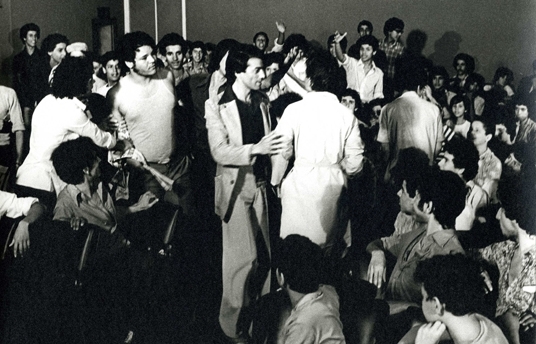Algerian Cinema: Caught between past and present - Part II
Nov 10, 2012
From past to present.
By DFI Programming Team
‘ Omar Gatlato ’ (1976) by Merzak Allouache is set in one of Algiers’ most popular neighbourhoods, Bab El-Oued. This film succeeded in breaking with post-independence heroism by diving deep into Algerian youth culture of the time. It also departed from the usual policy of post-war films to underline Algeria’s Arab Muslim identity that implied that even film characters from Kabylia had to speak a cleansed and artificial Arabic dialect. Omar Gatlato insisted on presenting the patch-work slang of urban youth instead. Moreover, it mocked prevalent male machismo as evident in the film title – ‘gatlato’ literally means ‘virility killed him’. The film created another strong contrast to the numerous national liberation war films.

Omar Gatlato (1976)
Heroism and mystification of the freedom fighter were paired with not giving any indications of internal current and historical struggles that have taken place within Algerian society itself. The wave of socialist oriented films produced in the 1970s that pictured the exploitative structure of traditional society that marginalised women and the poor started departing from that. Yet, most of these works, including the acclaimed ‘The Charcoal Burner’ (1972) by Mohamed Bouamari were quite idealist in their approach, uncritically advertising the modernist and socialist ideal.
Even though produced by the public Office National pour le Commerce et l’industrie (ONCIC), these films made attempts to please Algerian audiences by adding action scenes or other main stream elements. Yet most of them were not really successful, with the big exception of ‘Hassan Terro’ (1968) by Mohamed Lakhdar-Hamina starring the popular comedian Ahmed Rouiched as a reluctant hero. This work triggered a whole series featuring the same character, but this could not save state production. The rupture in the public sector came with the reorganisation of the indebted ONCIC in 1984, a first dismantling of the public cinema apparatus and its institutions in 1993, ending in a complete closing down in 1998.
Despitethe infrastructural crisis, the mid-1970s and 1980s saw an immense diversification of styles and approaches along with the persistence of social criticism, such in the case of Mohamed Chouikh and Sid Ali Mazif. Individual and human interest stories were brought in by Brahim Tsaki, while Jean-Pierre Lledo followed a more subjective and avant-gardist style and had to wait for this and other reasons several years to get his films made.
In general, Algerian television proved to be more daring in its approach to innovative and avant-garde works. In 1977, for example, the Entreprise nationale de production audiovisuelle (ENPA) produced Assia Djebar’s ‘ The Nouba of the Women of Mont Chenoua ’. Taking its title and structure from the nouba, a traditional song of five movements, Djebar’s film mingles narrative and documentary styles to document the creation of women’s personal and cultural histories.

The Nouba of the Women of Mont Chenoua (1977)
Farouk Belloufa’s ‘Nahla’ (1979), likewise an ENPA production, is also worth mentioning as a stylistically innovative but also highly cinematic portrait of Beirut during the Lebanese civil war. Yet the competition between television and public sector facilitated the latter’s successive disintegration. This in addition to the terror of the 1990s forced a great number of filmmakers and technicians into exile.
Related Posts:
Algerian Cinema: Caught between past and present – Part I
Algerian Cinema: Caught between past and present – Part III